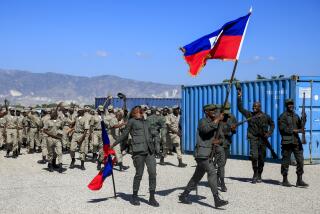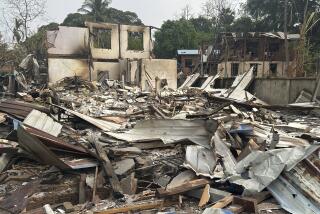Next Step : Cambodia Struggles Over What to Do With Its Armies : With a new transitional government in place, soldiers from the four major factions remain a threat to stability.
- Share via
PHNOM PENH, Cambodia — Now that a transitional government is in place in Cambodia after U.N.-supervised elections in May, attention has turned to the question of what to do with the thousands of soldiers who fought during more than a decade of civil war.
Like the proverbial loose cannon on a lurching ship, the armies of the country’s four major factions remain a threat to the stability of the fledgling regime. Quite apart from their ability to renew the civil war, desperate soldiers are increasingly turning to banditry to survive, creating a climate of lawlessness in much of the countryside.
Under the terms of the power-sharing arrangement reached last month, Prince Norodom Ranariddh, leader of the royalist FUNCINPEC party that won the largest share of seats in the election, and Hun Sen, who was premier in the old Phnom Penh regime, agreed to serve as joint ministers of defense as well as chairmen of the provisional government.
But diplomats and U.N. officials believe that this arrangement is a face-saving gesture and that most soldiers remain loyal to their officers in the four factions that waged the civil war.
Consequently, efforts are being concentrated on forming a new “Army of Cambodia,” which, initially at least, would include soldiers loyal to FUNCINPEC, the Phnom Penh regime and the Khmer People’s National Liberation Armed Forces (KPNLAF), a small, non-Communist force that received aid from the United States during the war.
Early plans for the new unified army did not include the forces of the Khmer Rouge, the dreaded Maoist guerrillas who abandoned the U.N.-mandated peace process in June, 1992, and refused to take part in the elections.
But after FUNCINPEC’s victory, the Khmer Rouge appears to have had a change of heart. Khmer Rouge military officers have told U.N. officials that they are now interested in being part of the new Cambodian army and are willing to allow a renewal of joint patrols with U.N. peacekeeping forces inside their zone of control, which is about 20% of the country. For the last year, the zone has been closed to virtually all U.N. officials.
Given the group’s gruesome past--an estimated 1 million Cambodians died of illness, malnutrition and terror when the guerrillas ruled Cambodia in the late 1970s--many in the country are reluctant to allow the Khmer Rouge to come back to the cities carrying weapons.
But many leaders such as Prince Norodom Sihanouk, the country’s head of state, have suggested that it may be safer in the long run to include the Khmer Rouge in the peace process, no matter how unappetizing that may appear, than to exclude it and risk resuming the civil war.
With between 10,000 and 12,000 disciplined fighters and an estimated year’s worth of ammunition cached in the jungles, the Khmer Rouge poses a significant threat to peace if its mysterious leader, Pol Pot, decides to resume warfare. Groups of Khmer Rouge soldiers have been seen moving freely throughout the country for several months.
According to U.N. estimates, the Phnom Penh regime has about 40,000 soldiers in the regular armed forces, which include a small navy and aging air force.
The royalist force numbers about 10,000 guerrillas, as does the KPNLAF. Both of these forces are located almost exclusively in the extreme northwest of the country near the border with Thailand.
Foreign military officers in Cambodia give the Phnom Penh army far higher marks than recent negative publicity about its performance might suggest. Although the army, known as the Cambodian People’s Armed Forces (CPAF), has not been able to prevent Khmer Rouge attacks, the guerrillas have been unable to seize any new territory and hold it.
There has been considerable resistance within the officer ranks of the Phnom Penh army to the idea of a joint armed force because, in the words of one Western observer, “until last month they felt that they were in the driver’s seat.”
U.N. officials said they expected initially that forming the new army would consist mainly of issuing new uniforms to the factions in hopes of replacing factional loyalty with dedication to the country and the new constitution being drawn up by the Constituent Assembly. The smaller factions will keep control of their areas, and Phnom Penh will effectively keep its troops in control of 70% to 80% of the country.
A first step toward integration may come Wednesday at a meeting of the Mixed Military Working Group, a committee of military leaders of the four factions set up after the October, 1991, international peace agreement.
It is from these ranks that a new general staff would be drawn. Ke Kimyan, a vice minister of defense in the Phnom Penh government, stands a good chance of becoming the new army’s commander. He is considered a “fence sitter” with no strong loyalties to any faction.
The first task facing the army’s joint command is a crisis over the country’s economic collapse. The treasury is empty, and many soldiers, who earn only $15 a month plus rice, have not been paid for months.
One U.N. official reported that the Phnom Penh army had been forced to fly payroll money to the battlefield because so many soldiers refused to attack on an empty wallet.
A number of soldiers merely work second jobs, such as guard duty in Phnom Penh. But a worrying number have turned to outright thievery to survive, including plundering the country’s architectural treasures at Angkor Wat for sale to Thai art dealers.
Many of Cambodia’s roads have become dangerous for travelers at night, and some are pronounced unsafe for the unarmed even at noon.
On the main highway between Phnom Penh and the provincial capital Kompong Cham, a squad of Indonesian troops assigned to the U.N. peacekeeping force leads a daily high-speed convoy of trucks, cars and taxis whose drivers are afraid of bandits. The burned-out hulks of wrecked trucks along the roadside bear testimony to the brigands’ ruthlessness.
Even the Khmer Rouge, long considered the most disciplined force, has not been immune to the problem. U.N. interviews with Khmer Rouge defectors disclosed that many of them gave up because they were too hungry to carry on fighting.
A plan has been discussed for several weeks under which five major nations--the United States, Britain, France, Australia and Japan--would provide emergency assistance of $60 million. The money would allow the various factions to pay their soldiers and civil servants during the three-month interim period in which the constitution is to be written and a permanent government chosen.
But those plans remain bogged down in bureaucratic wrangling over how the money will be paid, and there are fears that the Cambodians will not be able to meet the end-of-July payroll.
“The situation is really worrying,” said a U.N. official. “It could really undermine the entire peace.”
After the money issues are resolved, the commanders will have to deal with the thorny issue of demobilizing at least some of the thousands of soldiers who fought in the civil war. With the war over, the need for soldiers will be sharply reduced.
Cambodia suffers from huge unemployment, and turning the demobilized soldiers loose could send them back to banditry.
If the Khmer Rouge agrees to rejoin the peace process, the U.N. peacekeepers would be able to return to the unfinished job of sending 70% of the soldiers to special camps known as cantons and warehousing most of the big weapons nearby.
Once the Khmer Rouge pulled out last year, none of the three other factions felt safe enough to continue with the disarmament process.
More to Read
Sign up for Essential California
The most important California stories and recommendations in your inbox every morning.
You may occasionally receive promotional content from the Los Angeles Times.













